share this post on
To ensure new tech products add real value to our users, we created the Emerging Technology Canvas.


There are raging debates on the value of NFTs, hundreds of web3 products attempting to decentralise the web, and the big tech companies trying to claim first movers advantage over the Metaverse.
If you’re in tech, you’ll know change happens often and exponentially. New technologies come, some change the world, and others fall flat. We’ve seen extreme web3/Metaverse hype lately and the future of these technologies depends on one thing and one thing only; the value they provide people.
If Web 2.0 is composed of social media platforms, marketplaces and the creator economy, whatever comes next could be some combination of decentralisation, the Metaverse, NFTs, smart contracts and AR/VR. Teams everywhere are rushing to include the newly hyped thing in their products. Whatever your stance on these technologies; positive, negative, or unsure, one thing is for certain — there will be a next generation of the internet. New technologies will fuel new business models for new forms of value exchange. Silicon Valley believes we are at the start of a radical and exponential wave of this next generation.
When the new-tech hype-cycle begins, it’s hard to know if it’s something you need to immediately act on, or it’s just a passing fad. Is there unlockable value in the new technology, or is the hype just because of inflated expectations?
At Supercharge, clients come to us feeling they need to jump on the new technology as soon as possible or they’ll miss out. But creating something for the sake of it being new isn’t always the best route forward and often fails to deliver real problem-solving. Decision-makers buy into the hype, get a team together, and months later realise no one wants what was made. Judging by their customer’s reactions, it looks like Ubisoft is experiencing this right now with their NFT platform: (Ubisoft exec defends NFTs, saying players ‘don’t get it’).
So how do you build something useful when the technology is still in its infancy? When the chances of getting it wrong are high, your next steps need to be carefully considered.
Our Emerging Tech Canvas will help you to bring people back into tech-driven product development and make sure you’re building something actually useful.
The outcome will serve as a reality check; you’ll develop the concept’s scope, gain awareness of market readiness and be able to benchmark competitors (even if you think none exist yet).
We’ll focus on the early design phase; when you have an idea but you haven’t built anything yet.
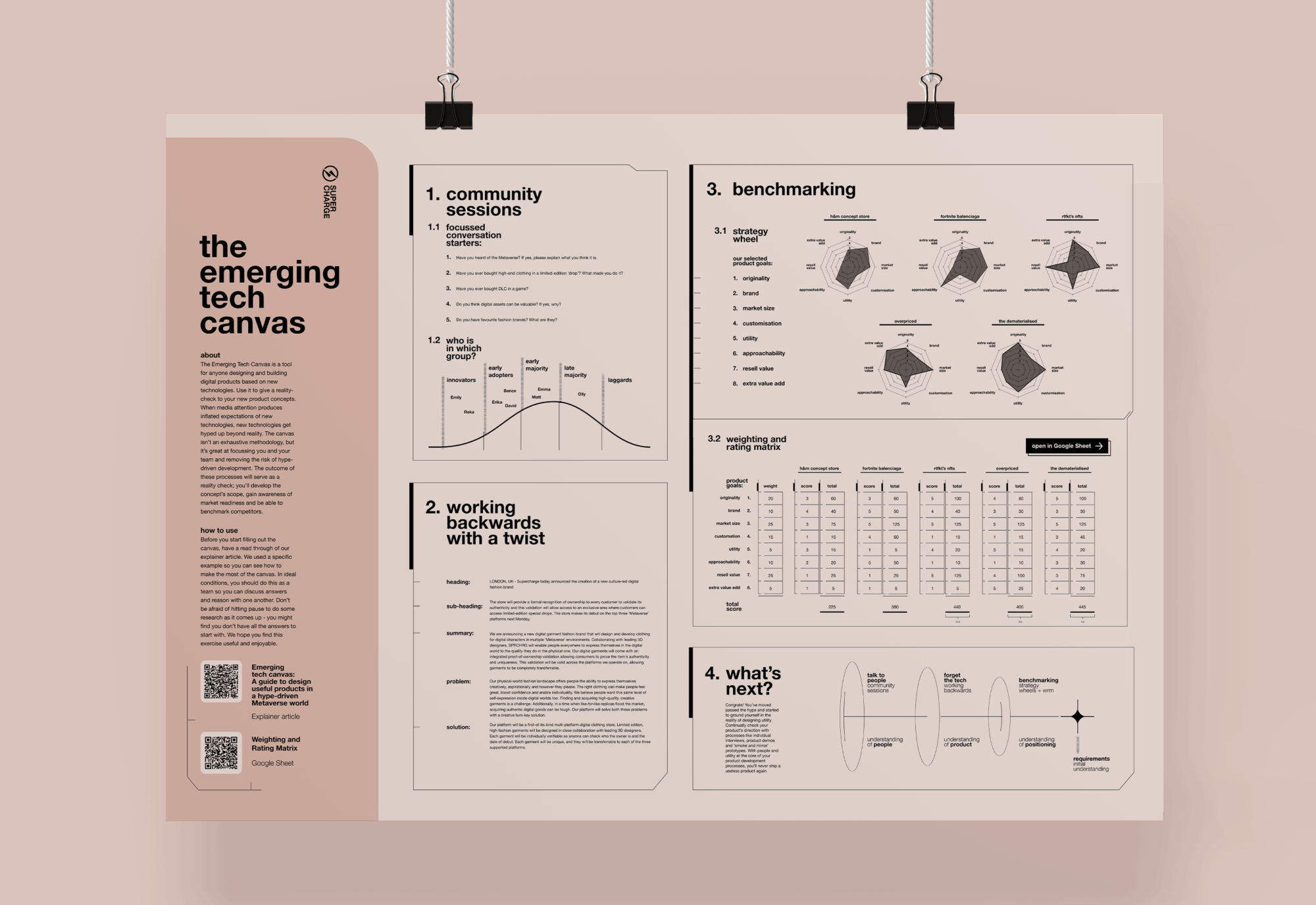
It should also be mentioned there can be outliers here. Sometimes new technology gets built that can’t be validated early on, has many doubters, no obvious value add, but still finds footing in a market eventually. This ‘lottery ticket’ style of product development isn’t what we’re covering here. We’re talking about designing digital products for real business growth.
I like to separate early-stage product concepts into two types; market-pull and tech-push. It may be a bit Business School 101, but thinking this way will allow you to focus your research efforts. If you’re certain you’re developing a product that real people need (and are willing to pay for), it’s probably a market pull. Your product solves issues people know they have. This is great because benchmarking is simple – compare your product to your (usually easy to find) competitors.
Tech pushes are a bit different. In a tech-push, no one knows they want your solution yet. You think new technology can solve a problem better than the current technology can, or maybe you think the new technology enables a completely novel way of doing something. You’re creating a new product based on new solutions, and hoping the existing market will adopt the new technology to solve its existing problems.
It’s incredibly challenging to develop useful products in a tech-push landscape. When the technology is ready but the market isn’t, even the tech giants fail. A few cases where the tech was ready but the market didn’t want it include: Apple Newton, Google Glass, 3D TVs, VR movies, and the list goes on. I’m sure there will be plenty of Web3 applications that end up on the list, either because of the lack of value prop or because the products aren’t usually very approachable.
Centring your tech-push product development efforts on problem-solving is an insurance policy against building something useless.
Realistically, a tech push doesn’t mean you can’t benchmark your product early on, even if the technology and method are radically different from the incumbents. Bitcoin is a good example of this. It was a completely new technology in 2009 – a new product with a new solution, created with the hopes the market would adopt the new technology to solve existing problems. In the Bitcoin whitepaper written by inventor(s) Satoshi Nakamoto, the proposed use cases are incredibly clear and well-defined. This is somewhat ironic because Bitcoin’s use is a hotly debated topic. The specific problems they were focused on were double-spending transaction duplication and high amounts of fraud and the resulting mediation. The overarching reason these problems exist is the involvement of a trust-based third party.
While the use-case was speculative and the technology was unproven, they constantly checked the technology against the real-world intended use. They speculated that it would be a replacement for online payments and that people could send money directly to one another, instead of through a high-cost third-party like Visa or Mastercard.
In reality, Bitcoin’s more common and unexpected use is as a store of value similar to Gold. Regardless of this, it was a system designed with a human-centred problem at its core. Every product decision Satoshi had to make could be made with these problems in mind. When that happens, you stop building useless things and start focusing on solving real problems.
So you’ve got a product idea and you need to figure out if it has a chance of providing real-world value. It might seem hard to tell before you’ve built it, but let’s do what we can. To demonstrate our techniques, let’s invent an example that we can stress test.
Our concept will take place in the Metaverse. From Nike to Balenciaga to Gucci, fashion brands are showing a strong interest in building digital stores in the Metaverse. The developers of Metaverse platform CEEK City recently debuted an H&M concept store. This allows users to dress their digital avatars in the latest in high-street fashion. Luxury fashion house Balenciaga proved there’s demand for custom, branded digital assets with their Fortnite partnership, which saw them design and sell digital outfits inspired by real-world garments. Additionally, Nike just bought RTFKT (pronounced ‘artefact’), a Metaverse design studio working on limited-edition, exclusive sneakers and other digital fashion accessories.
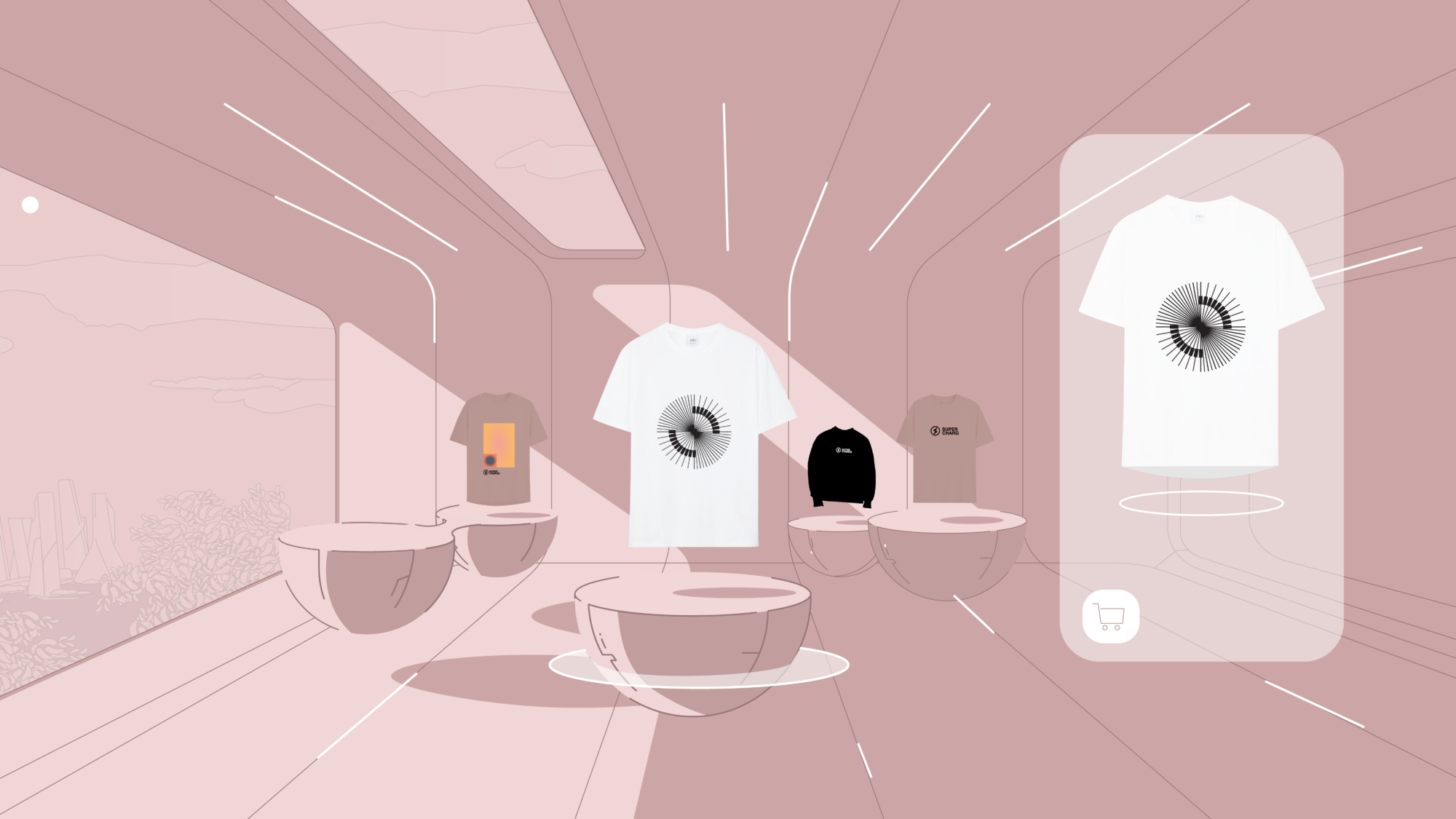
Based on this ongoing hype in fashion, we decided to create a conceptual Metaverse store for a new fashion brand. As all of this will require a lot of upfront investment, we want to validate the utility before we write the cheque. So, let’s run this initial idea through our Emerging Tech Canvas.
We’ll call the brand SPRCHRG… because nobody uses vowels nowadays. We’ll assume that people will be willing to buy digital assets like bags and jackets for their virtual avatars. As part of our value prop, we will prove the purchaser is the singular owner of the digital garment with an NFT (NFTs, explained). We’ll make our digital garments extremely exclusive by only selling one of each type in limited ‘drops’, and we’ll partner with top 3D fashion designers to create them.
Now, we’ll scope the new product requirements, talk to some potential users, and then try to identify and benchmark would-be competitors. This should give us a clear view of who will use it and what the value we’ll deliver is. These tools aren’t an exact science, they may not work in all cases, but they will provide guidance and bring you closer to your target users. Logically follow them to determine your potential users, potential competitors, and hone the problem you’re solving.
With all the Web3 and Metaverse hype going on right now, it’s easy to mistake tech bro’s tweets for ratified wisdom. First things first, let’s centre ourselves and create some focus.
Remember that you’re designing to improve real people’s lives and create something that will separate people from their hard-earned money. It should surprise no one that speaking to your demographic comes first and foremost, but it still needs to be said. It’s futile to ask people immediately if they like your concept because if it’s based on new technology, they probably don’t have existing experiences to compare it to. So how do you capture rich information about what works and what doesn’t?
Community Sessions will help you benchmark the market's understanding of the technology, gauge interest in your product, evaluate how you pitch it and draw out the weak spots of the existing solutions.
It doesn’t need to be overly structured, you don’t need to demo a prototype and you don’t need more than 5 minutes to prepare. Ask 3-4 people in your product’s demographic to join. If you’re not sure of the demographic, generalise what you know about the product and make a demographic from it. In the past, I’ve done this purely by age and region, so something like 25-35, Central and Eastern Europe can work. If you know more about them, great, get more specific than this, but even age and region can give you a good start.
Your task is to get the conversation started, and then move it in the right direction. You can come up with a few conversation starters to do this. Ask basic questions to break the ice. ‘Do you know what a Metaverse is?’, ‘Do you own cryptocurrency?’; anything that gives you some context and understanding of who they are and what they know.
Try to identify where they might lie on the Technology Adoption graph. If someone says they work in tech and own NFTs, they’re probably an ‘innovator’ on the graph and have some knowledge of blockchain tech. Ideally, you get a range of people that represent different groups on the graph.
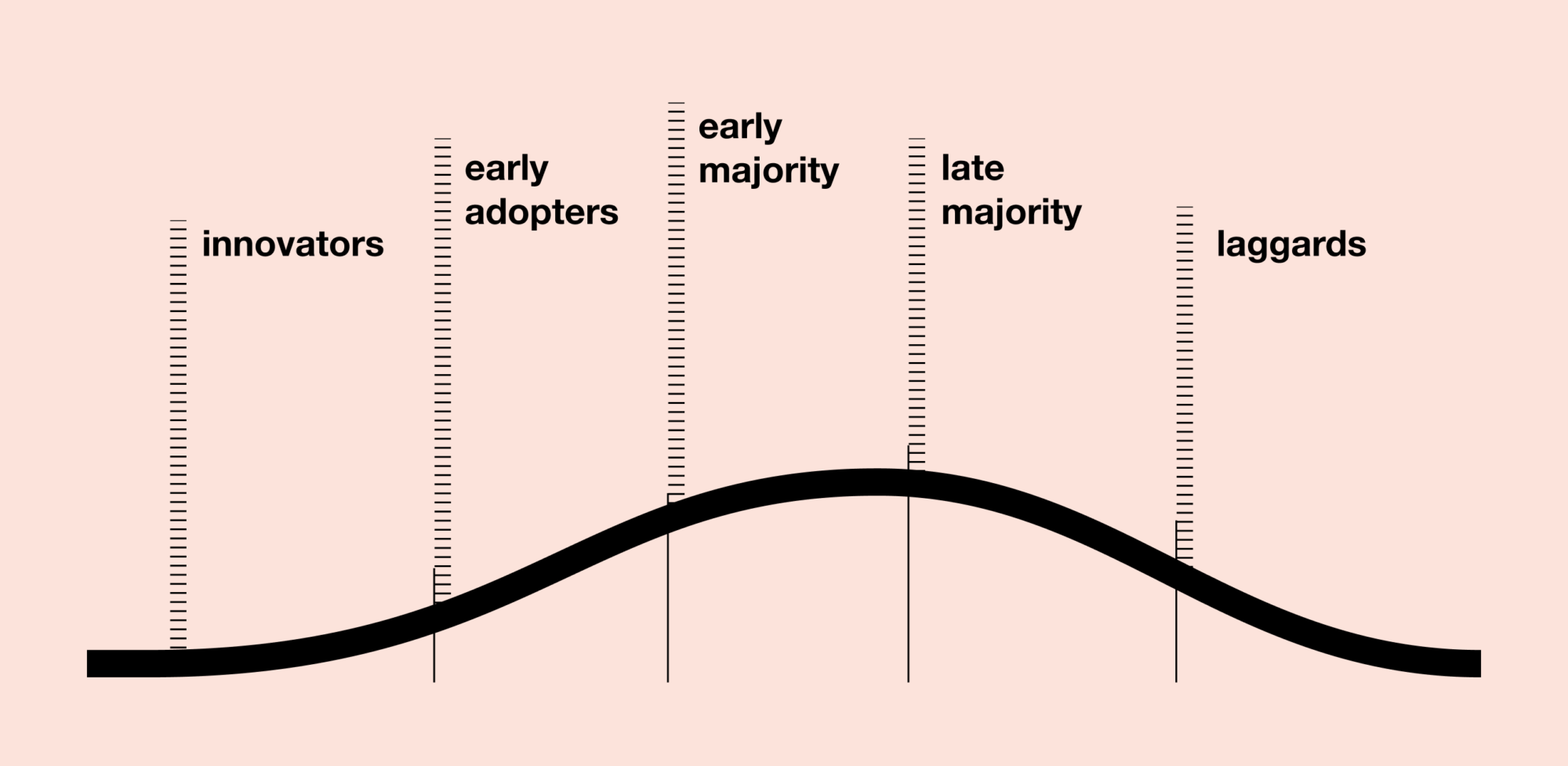
Tell them everything you’re planning. The goal should be to identify where the current solutions fall short and capture opinions on your concept. Explain why the new product will be better than the existing one. If they don’t understand anything, go back to the start and try to explain it jargon-free. This will be beneficial for your mental model of the product as well as theirs. This is qualitative feedback only; try to go deep. Run a few sessions and don’t plan more than 5 questions.
For our Metaverse fashion store, I’ll aim for a 25-35-year-old market, US-centric initially. The questions I’d plan are;
The group sessions should have given you some directed insight into how people perceive your product and the technology behind it. With these series of questions, we should be able to open the group up to discuss everything from the culture behind why some garments are more valuable than others, their view of the future of technology and the Metaverse, their readiness for it and general sentiment.
Once you’ve asked the questions, pitch them your product and ask for feedback. The scene is set so, hopefully, you’ll get a good amount of opinions, good or bad. You’ve now got real people – and their experiences – to think about when you’re making product decisions.
If you can't explain your new product without using 'decentralised', ‘metaverse’ or any other jargon, do you even have an idea?
Amazon’s ‘working backwards’ technique is great for scoping out a product concept before you’ve even started designing, and I’ll challenge you to take it a step further. The technique asks Product Managers write a mock press release to concisely explain their product concepts. They need to centre it around a chosen customer or market and describe how the current solutions fall short, and how the new solution will solve this. (You can find the full guidelines on Quora.)
To take it one step further, try doing this without mentioning the technology whatsoever. You can still describe the experience but do so in a tech-agnostic, jargon-free way. Cut out the buzzwords completely and describe the product contextually and with detail. This way, we can ideate on our product concept without using the technology as the differentiating factor. This will pave the way for the benchmarking we’ll do after. Try to keep it specific when it’s about the product, but vague with the technology.
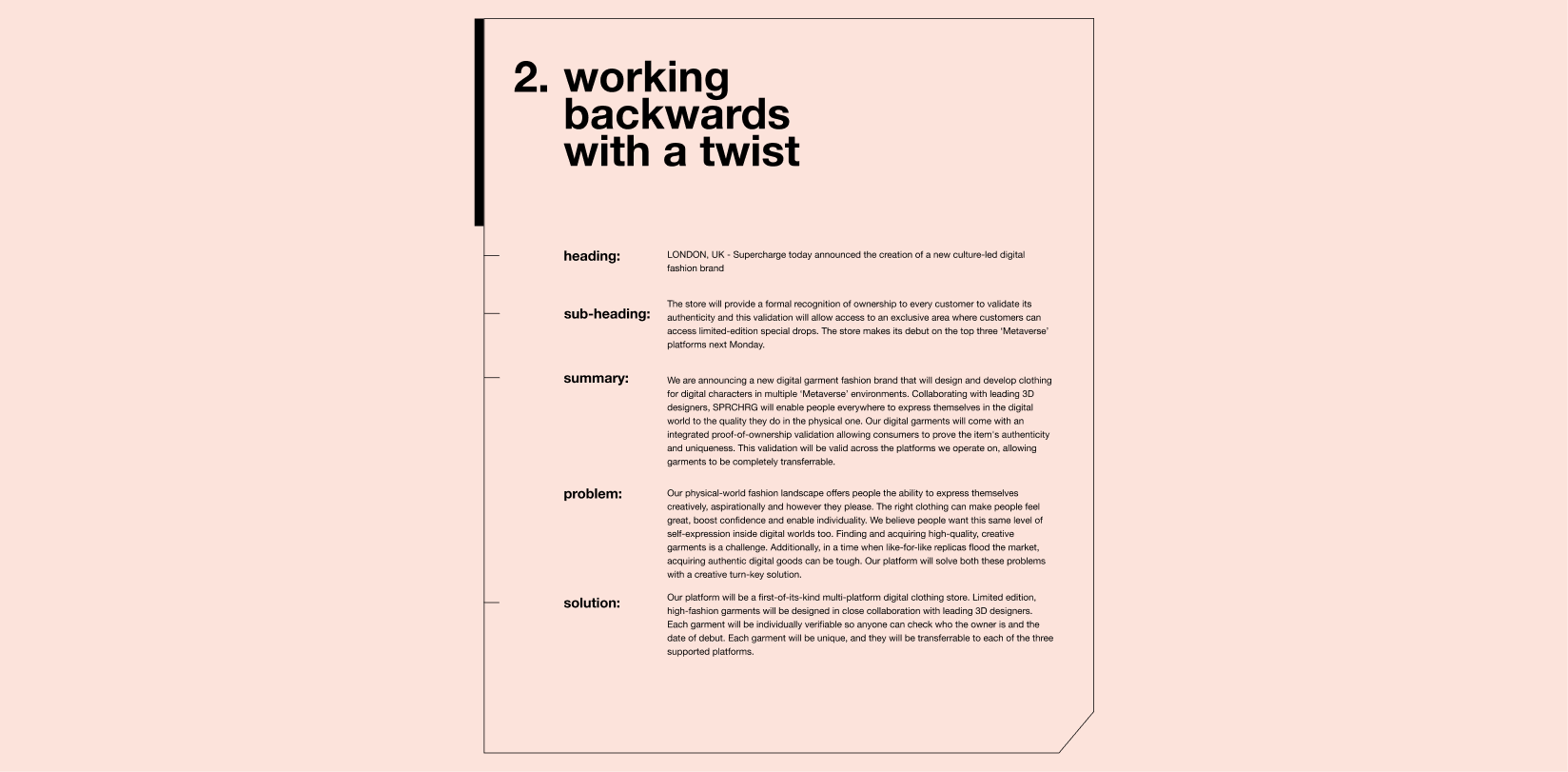
For example;
“Supercharge today announced a Metaverse store for NFT 3D assets…” or;
“Supercharge today announced the creation of a new culture-led digital fashion brand”.
Writing the press release will allow you to develop the concept free from the technology. You’ll be forced to focus on what makes the product concept valuable to its intended users, rather than just talking about how it will work. If the technology adds new value, it will still be included here. In our case, if we want to talk about the benefit of providing an NFT with each 3D garment purchase, we can say;
“The store will provide a formal recognition of ownership to every customer to validate its authenticity” and “this validation will allow access to an exclusive area where customers can access limited-edition special drops”
This way, it’s not about how we implement it, it’s about the end value to each customer. Now we’re able to look at this and compare other ways of recognising ownership of a garment, which will be useful in our market benchmarking to come.
Once you've whipped up your press release, you should have a clear, well-defined and jargon-free value proposition. This is a great position to be in. Now we know we're not just developing for the sake of technology, but we genuinely believe it adds new value to its intended customer and we have a good idea of how it will do this.
We can’t stop here though – the value won’t be actualised unless the technology can match the status quo competitors (in this case, web2 variants).
Now that you’ve got the press release, you can equalise the product concept in your mind with the rest of the market. The next step is to determine;
There is a myriad of benchmarking techniques out there, but here are two that are particularly useful for tech-centric applications. For our example, we’ll consider Web 2 versions of the product as well as more similar Metaverse/Web3 applications.
If you think there’s no Web 2.0 version, I’d suggest re-evaluating the press release – even radically new tech-heavy applications have some sort of current, existing way of doing things. Follow these benchmarking techniques to ID and evaluate some of the competitors.
A strategy wheel is a great way of visualising product comparisons. It’s simple to do, provides a good talking point and leaves you with a good understanding of who the competitors to worry about are.
The idea is simple; pick what you envision the cornerstones of your product to be. Take time to consider your evaluation points. The points you evaluate should be everything you think will make a product in your field truly great. Just as before, ignore ‘web3’, ‘metaverse’, and technology-specific evaluation points.
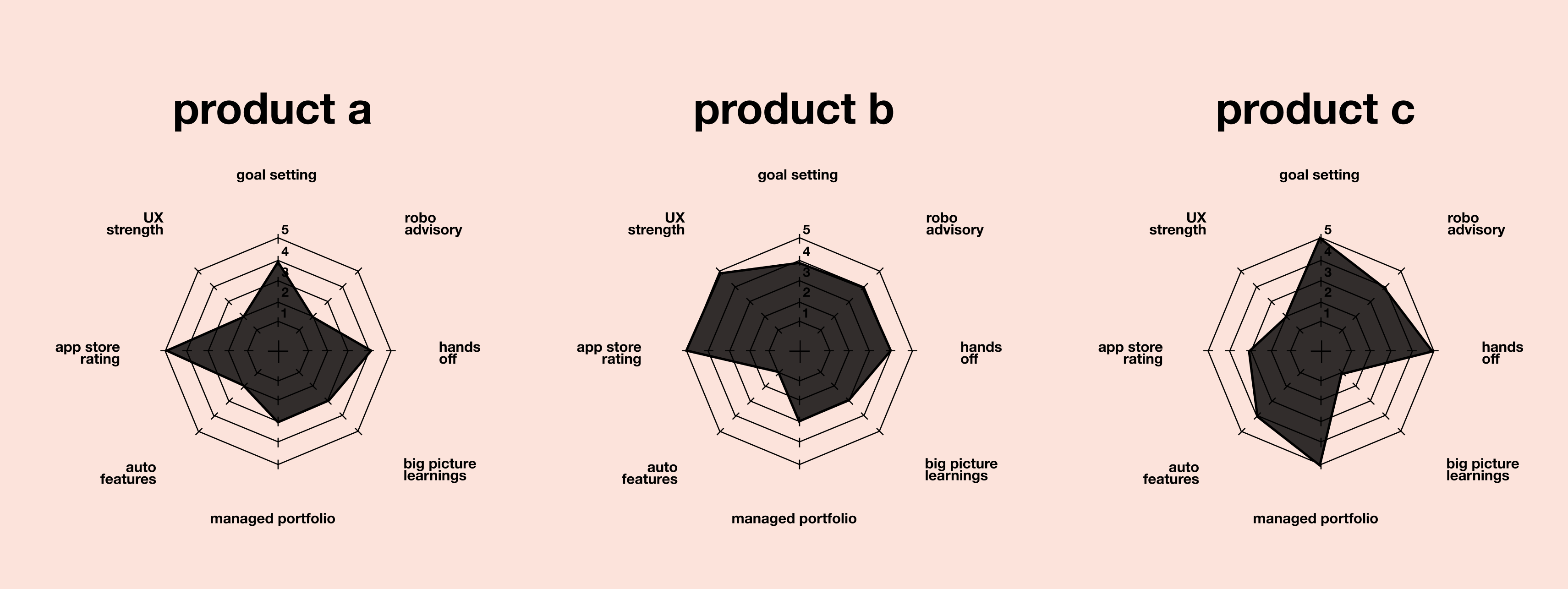
Create the wheel (or use our template), and label your evaluation points around the wheel. You’re now going to measure potential competitors against the wheel, and therefore against your product concept’s goals. Go through competitors one at a time, scoring each item from 1-5 along the line, with the highest score being the best, at the outermost part of the circle. You can select which competitors to choose based on your press release. For example, we don’t want to just consider like-for-like Metaverse stores, we want to frame our product concept in the tech-free way from before;
“Supercharge today announced the creation of a new culture-led digital fashion brand”.
This allows us to consider every product competing with what we’re trying to do – regardless of the tech and method. You should have a better idea of who these competitors are because of the previous step, but if you’re still uncertain, don’t worry, this will still be useful.
Rate every competitor you have the time for. The larger the shape, the more closely aligned your competitor is with what you are trying to do. Focus on the principles that will deliver the value; not how you will deliver it.
For SPRCHRG, our metaverse store, I picked these principles for their relevance. If you’ve nailed the press release before, you should just be able to pick and choose words from that. Here we have;
Be as measured as possible when you’re scoring. For example, if something is quantifiable (like market size), do a quick search. For those that aren’t, try to curb your bias. If you’re working as a team, do one wheel at a time as a group and reason with each other to justify the scores you’re assigning. Once you’ve got scores, draw the shape to connect them all. Ideally, you have a big enough range to tell who the closest competitors are, and who you can ignore.
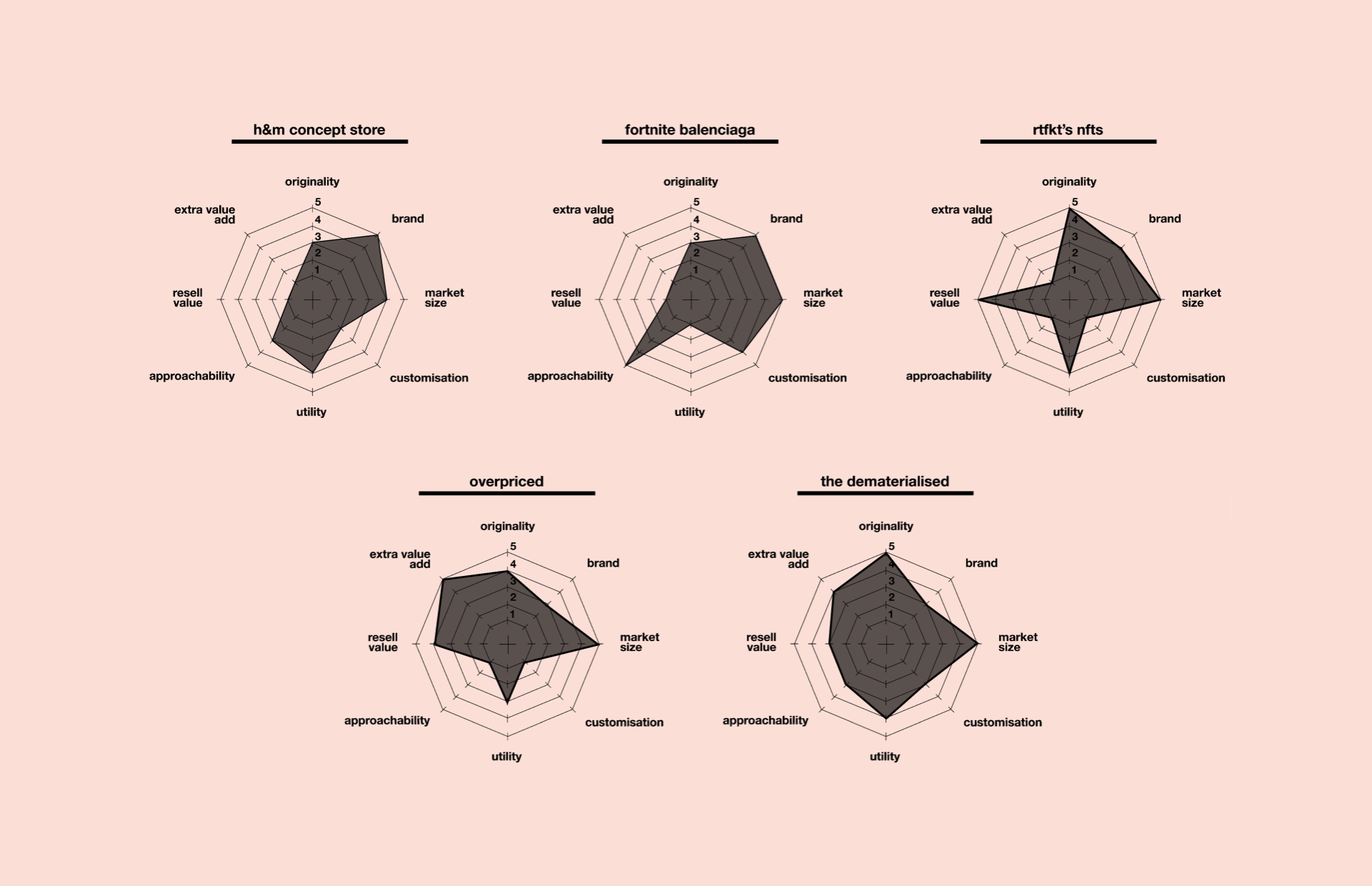
We can see from this that we should consider Overpriced and The Dematerialised to be closer competitors than the CEEK H&M concept store; something that might be surprising. Throughout the board, some common issues come up like approachability.
Many of these web3 applications require a dictionary of initialisms to bridge the knowledge gap. We’ve highlighted it as a goal of our product concept, so we’ll need to solve this. Market size is also an interesting one; it’s intrinsically linked to the platform we’re building the store in. This means we’re at risk of selecting a platform with a limited user base, or one with approachability issues. Conversely, we can see where our competitors are strong. Originality and brand are everything in fashion, and the Metaverse is no different. From here, let’s order our product goals by priority to define our focus.
The last exercise was good for identifying competitors you should focus on and showing how rounded their products are, but it treats everything with equal importance. The reality of product building is that you need to prioritise. Build on the learnings from the Strategy Wheels with a Weighting and Rating Matrix.
Write down each of the evaluation points and assign a weighting. Be open to changing priorities and discuss with your team. You can use our Google Sheet for speed. Using the same scoring from the strategy wheels, go through the competitors and plot the scores for each product.
If we want SPRCHR to reach a large audience, it will need to get past the “innovators” part of the tech adoption graph. This places high importance on approachability, so we should score that highly. Using the same product goals as before, assign a prioritisation score to each item in the ‘Weight’ column. This will challenge you to focus on the most important parts of the product concept. In our example, we can see The Dematerialised’s added value scores high. It’s a great idea and looks good on the strategy wheel, but for us, it’s not a core part of our concept. In our case, these are ‘nice to haves’ that can come later, not fundamentals that should be built first.
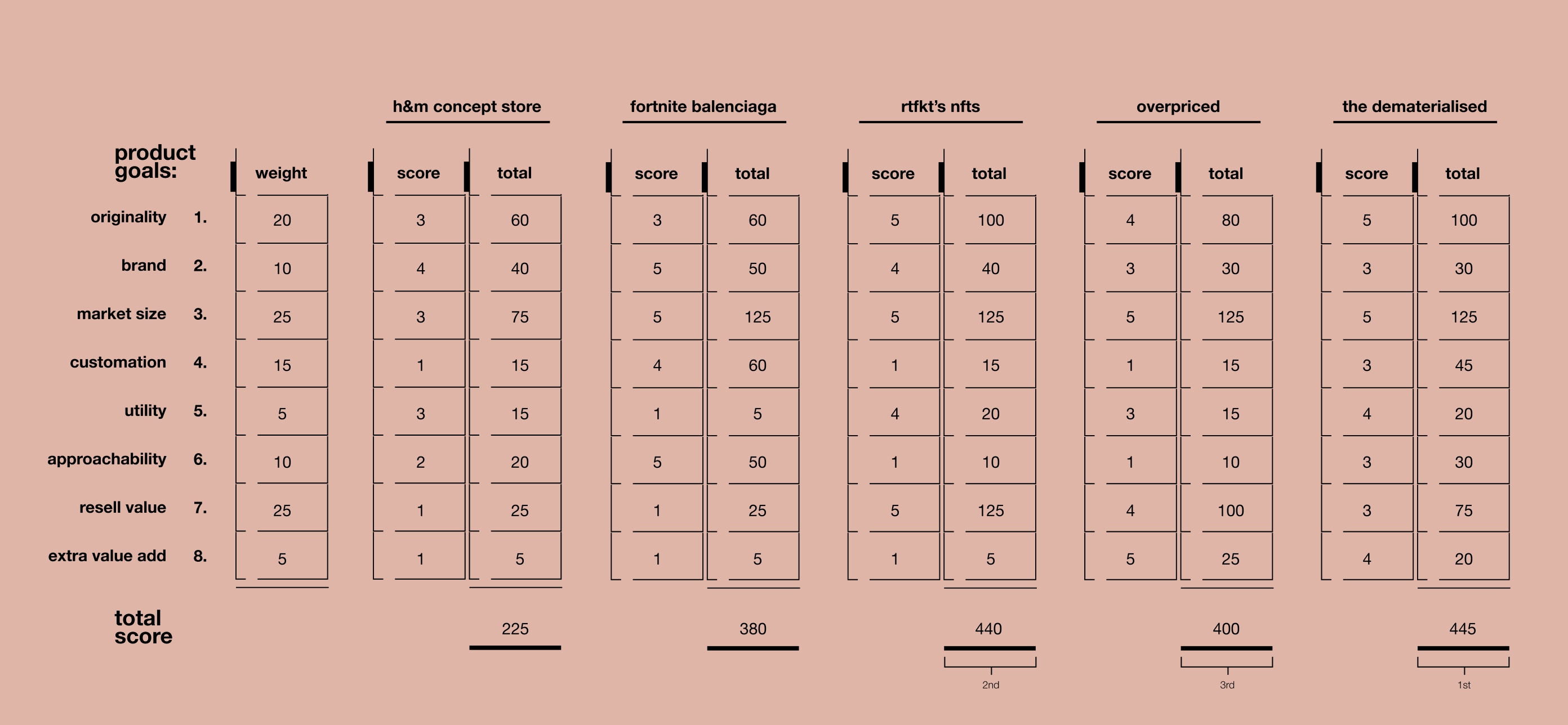
You’re left with a tailored list of competitors ranked by which are most applicable to your product concept.
You can move from focussing on the products gaining the most media attention to those more relevant to your concept and demographic.
For SPRCHR, even though we are creating the store in the Metaverse, the products currently serving our market are actually companies with a focus on building NFTs. When we start designing our product, we’ll know that Originality, Resell value and Market size are our top priorities. We can make decisions based on this. We’re able to think about these core priorities, see the end value (free from the tech) and connect it to specific people we spoke to in the Community Sessions. In other words, we’re ready to start designing.
Every new tech wave starts in a wild-west-like free-for-all where the hype is king; there is no normal yet. That’s especially true for web3 and the Metaverse right now. It’s great to get excited by the hype, but it’s a double-edged sword. When you find yourself working on these kinds of projects, don’t shy away from doing an exercise like this because “it’s a technical project”, “it’s too early stage”, or it doesn’t seem applicable. It’s never too early to consider if your product concept will be useful, and the sooner you check, the sooner you can course-correct.

This process doesn’t stop when the canvas is filled out. When you have something to show, show it to anyone who will look. As your product develops, turn community sessions into individual interviews and turn those interviews into product demos. Use smoke and mirror prototypes and then use MVPs and then use analytics, north star metrics and so on, so forth. With people and utility at the core of your product development processes, you’ll never ship a useless product again.